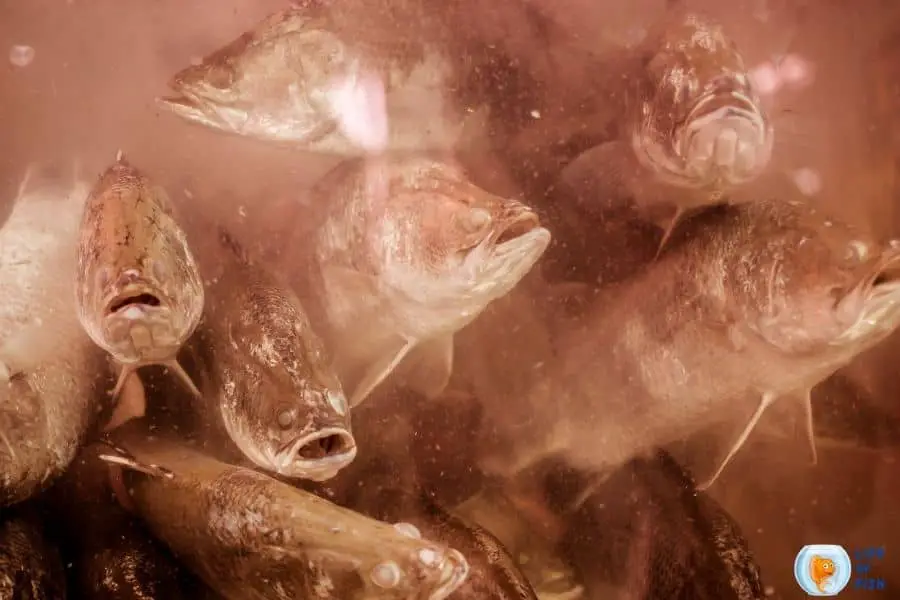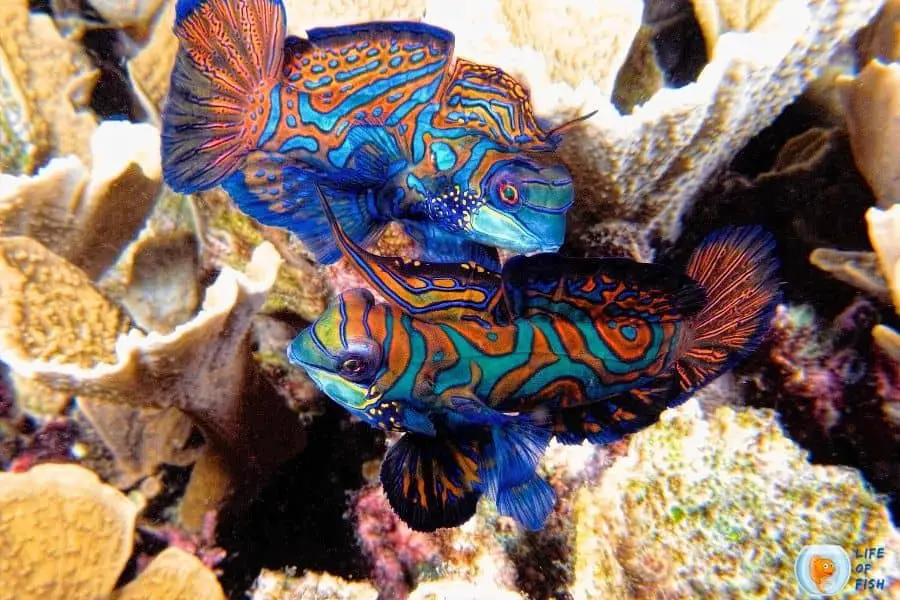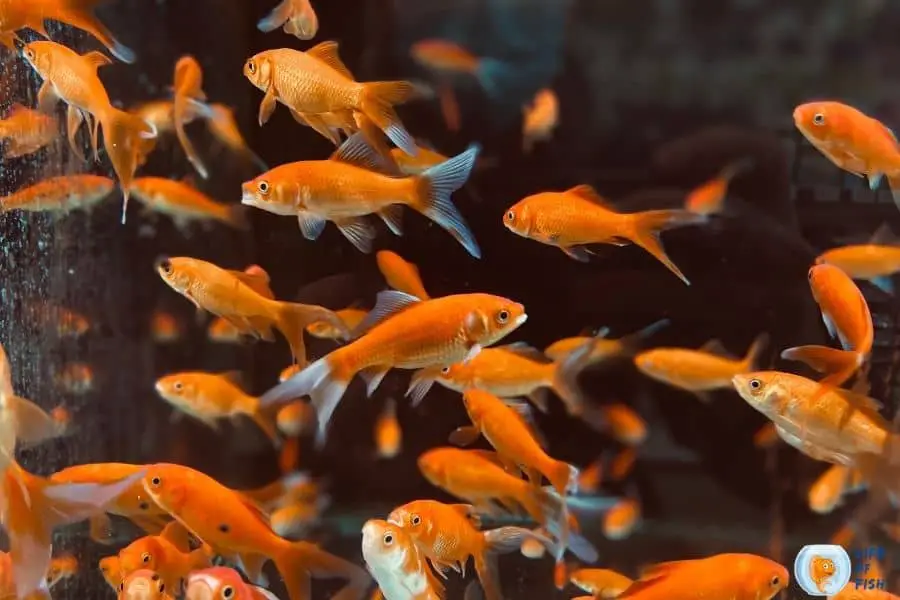“Fish become aggressive” is often related to many fish species. Some species are naturally aggressive, while others are peaceful, and some fish species stay on the middle road.
For instance, if they are fish species that migrate from peaceful to aggressive behavior as soon as the mating season arrives, they can be unpredictable. Aggressive fish can be a problem for both the fish keeper and the other fish in the tank.
So, why do fish become aggressive? Let’s talk about this topic in this article.

Why do fish become aggressive?
Jump To
- 1 Why do fish become aggressive?
- 2 Why is one of my fish chasing the other?
- 3 Fish suddenly aggressive
- 4 How do you know if fish are fighting or playing?
- 5 How do I know if my fish are mating or fighting?
- 6 What does it mean when a fish is semi-aggressive?
- 7 Aggressive fish in tanks
- 8 How do I stop my fish from being aggressive?
- 9 Should I remove an aggressive fish?
- 10 Can aggressive fish live together?
- 11 How to tame an aggressive fish?
- 12 Fish bullying other fish
- 13 How long to isolate aggressive fish
- 14 Fish aggressive during feeding
- 15 Why is my goldfish so aggressive?
- 16 Do fish bond with each other?
- 17 Recently asked
There can be one or several reasons for fish to become aggressive.
Some naturally aggressive fish become aggressive when other fish invade their territory. Some others become aggressive when they get hungry. This is especially true for carnivore fish.
Some fish become aggressive when they are spawning. The males become very territorial and aggressive when they are trying to protect their nests and eggs. This can be a problem for the other fish in the tank.
Be careful with fish species that become aggressive during their mating season. Some female fish, for instance, can become very aggressive and territorial during their spawning season.
It is good to keep them with a group of females, as they may attack any other fish that tries to come near them.
Fish may also show aggressive behavior when they are sick. Some other fish become aggressive towards ill and weakfish.
So, as you see, it is difficult to tell the exact reason why fish become aggressive. To learn the precise cause, you often have to observe their behavior patterns closely.
Some of the most territorial fish species include sharks, piranhas, and anabantoids (e.g., gouramis). By the way, tropical fish become more aggressive when kept in tanks that are too small. So, don’t keep your fish in a too-small tank for them.
Why is one of my fish chasing the other?
Typically fish chase each other for various reasons.
- To establish their dominance
- To compete for food
- When mating and
- defending their territory.
Some fish chase others when they are stressed. Fish often become stressed in poor water conditions, when housed with incompatible tank mates, when they become sick, or in an overcrowded tank.
If they are stressed, you should try to solve the problem. But if it is because they want to establish their dominance, then there is no need for you to intervene.
You can solve competition for food, a mating problem, or territorial aggression by separating the aggressive fish from the others.
When the problem is caused by stress, you should try to improve the water conditions or find a way to reduce the number of fish in the tank.
Fish suddenly aggressive
If your fish is ordinarily peaceful and docile and suddenly becomes aggressive, it is most likely because of stress.
There are many reasons why fish become stressed. Poor water quality, overcrowding, being housed with incompatible tank mates, and becoming sick are common reasons.
If you can’t determine the cause of the stress, you may have to watch the fish’s behavior closely to see what is stressing them. Once you decide the reason, you can take measures to correct it.
Your fish is in a tank with other fish and one of them is sick, you should remove the sick fish from a hospital tank.
If your fish are stressed because of overcrowding, you should reduce the number of fish in the tank. If the water quality is poor, you should improve it.
How do you know if fish are fighting or playing?
When fish are fighting, the scared fish are more inclined to cower in a corner rather than charge head-on.
Rather than swimming toward the aggressor, the fish that is trying to protect itself will seclude itself. In other words, when more aggressive fish swims towards it, the weaker fish will tend to hide.
You can also look at how they “communicate.” Usually, when one of the fighting fish lands a hit, the other fish will immediately react.
It may turn on its back to show that it is hurt or slap its tail on the water to warn the other fish.
When playing, the attacking fish will try poking the other one to provoke it into chasing it. It is pretty clear when fish are playing because they will usually swim away when they have had enough. They won’t react aggressively, and there is typically no fin-nipping when they are playing.
If you want to know how to tell the difference, you have to observe their behavior closely. You will only need 3 to 5 minutes to determine if they are fighting or playing.
How do I know if my fish are mating or fighting?
If your fish are fighting, you can see that they bite and nip at each other.
When you see a fish pair chasing each other and they are not biting or fin-nipping at each other, they are likely mating.
If the fish are fighting, one of them will usually turn on its back to show that it is hurt or slap its tail on the water.
When fish are mating, the chasing of each other will look more like a “dance.”
The female will follow the male, and he will try to corner her. Once he is successful, he may begin a “dance” with her.
When you see this behavior, watch closely to see how long the “battle” lasts. If it is over within a few minutes, they are probably mating. If they are fighting, the battle will likely last longer than 5 minutes.

What does it mean when a fish is semi-aggressive?
A semi-aggressive fish means that fish become aggressive under certain circumstances.
Usually, these fish become aggressive when threatened when other fish try to dominate them or when they are guarding their territory. Some semi-aggressive fish become aggressive during spawning.
Semi-aggressive fish often get along well with peaceful fish species because peaceful fish do not try to dominate them or take their territory.
The best way to deal with a semi-aggressive fish is to watch its behavior and identify what is causing it to become aggressive.
Once you know the cause, you can take steps to correct it. If the fish is guarding its territory, you may have to add more decor or plants in the tank to make it feel less threatened.
If the fish is becoming aggressive during spawning, you may need to remove the eggs or fry to another tank.
Aggressive fish in tanks
Some fish are naturally highly aggressive and do not get along well with other fish species. These fish are better kept alone or in a species-only tank. Some well known freshwater aggressive fish species are,
How do I stop my fish from being aggressive?
If your fish are becoming aggressive to the point that they get hurt so badly, you should make some adjustments in your tank as first attempts to avoid that behavior.
- Separate aggressive fish with a net
- Change the aquarium decoration. Rearrange the decorations or add more.
- Increase hiding spots in the aquarium
If these changes don’t work, you can transfer them to a bigger tank to lessen the overcrowded problem.
If your fish fight each other even after that, you will have to either move your aggressive fish to a new tank or give them away.
Should I remove an aggressive fish?
Not necessarily if your fish is semi-aggressive, semi-aggressive fish usually do well in a peaceful community, and you just have to provide adequate space for each fish.
But if your fish are naturally highly aggressive (like Arowana, betta, garfish, etc.), you must remove them from a community tank.
Otherwise, the aggressive fish will end up killing other fish species. Highly aggressive once are better kept alone.
Can aggressive fish live together?
That depends on each fish species. For example, Angelfish can live together even though they are aggressive.
Some aggressive species like bettas and certain Arowanas can live with other aggressive fish as long as they do not look alike.
How to tame an aggressive fish?
Taming an aggressive fish isn’t easy. It generally takes a lot of time and patience, but it can be done. You may need to try different methods until you find one that works for your fish.
(Note: This method will work only with peaceful fish that suddenly become aggressive or semi-aggressive fish. If your fish is a highly aggressive fish like Arowana or garfish, then it is not possible to tame them most of the time)
The first step is to identify the cause of the aggression. Once you know what is making your fish aggressive, you can start correcting it.
If the aggression is caused by territoriality, you can add more decorations to make the fish feel less threatened.
The aggression is caused by spawning, you may need to remove the eggs or fry to another tank.
If you cannot identify the cause of the aggression, you may have to start from scratch and retrain the fish. This usually involves slowly introducing new tank mates until the fish becomes comfortable with them.
Before getting an additional fish, you should determine if your current fish will let it stay in the tank. Even peaceful species can become aggressive when spawning, so keep that in mind.
Remove any existing tank mates to a temporary tank or give them away before adding new ones to your main tank.
Add the new fish very slowly, a few at a time over a period of weeks.
Observe the new fish and remove them immediately if they are being bullied or harassed by the existing fish.
You can eventually add all the new fish back to the main tank if all goes well.
Remember that it may take some time, but you can usually tame an aggressive fish with patience and observation.

Fish bullying other fish
In this situation, usually, the bully fish is a highly aggressive carnivore fish. If this is the case, you will have to separate the bully into a new tank.
If your fish is generally peaceful in the community tank and suddenly becomes the bully, the nit is most likely in heat and breeding.
Fish often become aggressive and territorial when they breed. So, it is better to separate the breeding fish pair into a breeding tank until they finish laying eggs.
If the parent fish are protective around their eggs and fry, you will have to keep them separated until the fry becomes free-swimming.
How long to isolate aggressive fish
If you temporarily isolate your aggressive fish, you should keep them separated for at least a week or two.
This will help the other fish to rearrange their hierarchy, settle in the tank, establish dominance and gain confidence.
So that when your aggressive fish are being reintroduced, they won’t have a chance to dominate as there is already a dominant fish in the community tank.
Fish aggressive during feeding
You can easily avoid this behavior by using feeding circles.
Feeding circles are a way of arranging the food so that the aggressive fish cannot reach the food of peaceful fish because they are already busy eating in a feeding circle. You can make a feeding circle by using a floating divider in the tank or using a floating tube.
Another way to reduce aggression during feeding is to feed smaller meals more often than one large meal.
Why is my goldfish so aggressive?
Goldfish are usually peaceful fish that do well in a community tank. But, some goldfish become aggressive sometimes. The most common reasons are if fish are jealous of each other or if the tank is too small.
Jealousy is more common in goldfish than other fish. Because of their long fins, some female goldfish can appear to be the more dominant fish in the tank, even if they are not.
This can cause the male goldfish to become aggressive to protect his territory and mate.
This can be prevented by adding more tank decorations, having more than one female goldfish, and giving the fish plenty of space.
If your fish tank is too small, the fish may become aggressive because they feel threatened. This can be prevented by increasing the size of the tank.
Do fish bond with each other?
According to a study, fish also have feelings and emotions. Certain fish species (like convict cichlid) feel emotional pain and become glum and pessimistic when they lose their partner.
This may not be true for all fish species, but further study is needed.
Recently asked
Why is my goldfish attacking each other?
If your goldfish are attacking each other, they are most likely jealous of each other. In this case, you will have to separate two fish into separate tanks.
Sometimes, goldfish fight when the tank is too small. If this is the case, increasing the tank size often solves the problem.
How do I stop my guppy from being aggressive?
Guppies are good tank mates in community tanks. They are usually peaceful with other fish if given enough space to roam.
If your guppies are aggressive, you should provide enough hiding places and rearrange the decorations first. Increasing the tank size is the best solution if that doesn’t work.
Read Next : Are Molly Fish Aggressive? | 18 Things Must Know 8 Non Aggressive Cichlids for Community Tank And Care Betta imbellis The Peaceful Member Of The Aggressive Family
